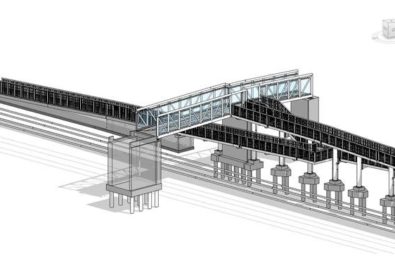
The proposed footbridge would replace the existing footbridge that provides access from a parking area off Bedfont lane, adjacent to the station and over the railway line, into the multi-storey car park on the southern side of the railway line and into Feltham town centre.
challenge
There was uncertainty if the Radiance Software would successfully provide the effect of glazing within the bridge and also to the sides and their effect on the driver approach. Without enhancing the techniques for glare analysis and how the technique can be effectively used on a glass bridge structure directly above the railway was a great risk and challenge.
However, potential risks arise from the development of the new structure regarding possible reflected sunlight from the façade. The glazed areas of the building have the potential to cause visual obstruction or distraction to train drivers on the adjacent viaduct. The potential risks of sunlight reflection and glare is therefore provided in this report.
We approached this complex problem by using a software based methodology we adopted for the rail industry and improving this to include the risk of the glazed bridge but also glazing of the parapet glazing on either side of the new development. This modelling also required inserting each each glazed parapet into the model.
There was uncertainty if the Radiance Software would successfully provide the effect of glazing within the bridge and side parapet also to the sides and their effect on the driver approach. Without enhancing the techniques for glare analysis and how the technique can be effectively used on a glass bridge structure directly above the railway was a great risk and challenge.
solution
For the purposes of sunlight simulation, various elements of the 3D model were applied with reflection properties approximated by images of materials Q Sustain received via Osborne.
The methodology for this stage of simulation is described below:
- Create routes for the trains passing the development that travel eastbound and westbound through the significant reflections.
- The model reflection properties were provided by
the designers. - Simulations were completed at ten frames/second along the railway lines at driver eye height (2.75m above track) The frames were then combined into a real-time animation at 30mph to simulate the speed of the passing train.
A mathematical algorithm was also applied to each frame to predict the magnitude of any disability glare using the Hassall method. Using this data, graphs were created which identify the veiling luminance (disability glare) over time and the difference between the static façade and reference façade.
The creation of an improved Radiance software 3D sunlight simulation model for the bridge based on the Architect’s 3D model was created and tested successfully, but further refined and improved with various viewpoints across the track approaching the bridge and including signal graphical data.
Using the software, we ran the 3D animations including further improved view of the nearby signals to more accurately represent the train drivers view. This study also calculated the intensity of reflection onto any signal that may create signal lamp ‘Wash Out’ where there is the possibility of a reflection illuminating the signal directly which could possibly cause a ‘phantom aspect’.
Sustain also generated 3D computer animations of the train driver’s simulated viewpoint travelling each way along the railway tracks adjacent to the site during periods of predicted potential glare using an alternative Etched glass material that was not modelled before. This was researched in detail.
A sample of Guardian Satin Deco (etched Glass sample) was tested using a high dynamic
range photographic technique, calibrated with luminance measurements, to assess if the
material exhibits perfect diffusion characteristics or semi-specular characteristics and to
establish the reflection performance. Luminance measurements were also taken to
approximate the percentage of diffuse reflection.
